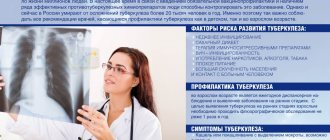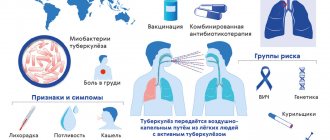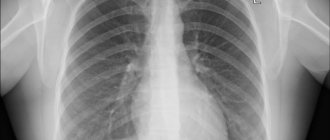V. I. Petrenko, V. F. Moskalenko, Yu. I. Feshchenko, N. N. Savula, S. S. Soldatchenko
To study the prevalence of tuberculosis, the following epidemiological indicators are used: infection rate, morbidity, morbidity and mortality, risk of infection, infectiousness parameter.
- Factors of infection
- Tuberculin reaction
- Tuberculosis incidence
- Methods of infection
- The influence of environmental factors on morbidity
- The influence of other diseases on tuberculosis
- At-risk groups
- Mortality and lethality in tuberculosis
- Tuberculosis statistics
- The threat of tuberculosis today
Infection rate is the percentage of the number of persons reacting positively to tuberculin to the number of those examined, excluding persons with post-vaccination immunity. Human infection is detected using the Mantoux tuberculin test with 2 TU PPD-L. It largely characterizes the reservoir of tuberculosis infection. However, a positive tuberculin test can also be a consequence of post-vaccination immunity. After vaccination, the infiltration of masses has characteristic differences from the infiltration of infectious allergies, which are used for their differential diagnosis. The infection rate characterizes the epidemiological situation, which does not always correspond to the incidence rate, since the decrease in the incidence rate outpaces the decrease in the infection rate.
Factors of infection
Infection in the population increases with age. Among city residents it is 5-10% higher than among the rural population. In recent years, our country has seen an increase in the infection rate of the population, which is associated with a sharp decline in its standard of living. According to Yu. I. Feshchenko (2002), in the current conditions of the tuberculosis epidemic, the incidence rate of children aged 7-8 years is 8.5%, at the age of 13-14 years - 19.5%. In people under 40 years of age - 80-90%. An important role in reducing infection is curing tuberculosis patients or achieving abacteriality. This limits the spread of Mycobacterium tuberculosis in the environment and helps reduce the level of infection in the population.
The study of tuberculin tests shows that widespread antibacterial treatment of tuberculosis patients reduces the severity of tuberculosis infection and changes the immunological reactivity of people. People with hyperergic reactions get sick more often than those with hypoergic reactions, so they are considered to be at increased risk of tuberculosis.
Treatment
Tuberculosis can be treated and cured. For active drug-sensitive tuberculosis, a standard six-month course of treatment with four antimicrobial drugs is given, with patient education and support from a health worker or trained volunteer. Without such support, it is more difficult to adhere to the treatment regimen.
Since 2000, it is estimated that 63 million lives have been saved by diagnosing and treating tuberculosis.
Tuberculin reaction
After the patient is cured, the tuberculin reaction remains positive and does not yet indicate the presence of not only infection, but also immunity. The tuberculin reaction is, first of all, an immunological reaction. The results of tuberculin diagnostics do not reflect the epidemiological situation: tuberculosis. More precisely, the effectiveness of the fight against tuberculosis is characterized by the risk of infection, that is, the increase in infection. The risk of infection is the percentage increase (%) in the number of people infected during the year. This figure should not exceed 1%. If the risk of infection exceeds 2%, then at 70 years of age 90% of the population will be infected.
What kind of prevention?
The disease is transmitted through the air, and it is impossible to completely protect against tuberculosis. In addition, tuberculosis does not leave behind antibodies, so you can get sick with it several times.
Today, newborns in maternity hospitals are given the vaccine against tuberculosis - BCG (Bacillus Calmette-Guerin), but it also does not completely protect against infection, but only reduces the risk of infection and the development of severe forms of tuberculosis.
3575
On the altar of parental beliefs: what does a world without vaccinations turn out to be like?
Doctors recommend that adults and adolescents over 15 years of age adhere to a healthy lifestyle, do not smoke, do not drink alcohol, and undergo fluorography once every two years. For children from one to 14 years of age, an early diagnosis is tuberculin testing - the Mantoux test, which is regularly done in schools.
Tuberculosis incidence
Morbidity is the number of newly diagnosed patients with active tuberculosis per 100,000 residents of a given area during the year, and morbidity is the total number of patients with active tuberculosis per 100,000 residents of a given area at the end of the year. By 1998, relapses of previously suffered and cured tuberculosis were not recorded in Ukraine. Since 1999, such cases have been included in the incidence rate.
To study the dynamics, the incidence rate is compared with similar data for previous years and indicators in other administrative territories. The absolute number of newly diagnosed patients over different years is also compared, taking into account changes in population size. The incidence rate by localization and clinical forms of tuberculosis of the respiratory organs and extrapulmonary localization is being studied.
The quality of the diagnostic work of the anti-tuberculosis dispensary is reflected by the request; weight among patients with newly diagnosed tuberculosis, the presence of bacterial excretion and the process in the decay phase. Detection of the release of Mycobacterium tuberculosis or the collapse of lung tissue in a newly diagnosed patient is regarded as untimely detection. In the case of highly qualified workers of the X-ray and laboratory departments of the anti-tuberculosis dispensary, their equipment and organization of work, the proportion of patients with bacterial excretion should be higher than or equal to the frequency of detection of destructive phenomena. High numbers of these indicators indicate the low quality of work of the anti-tuberculosis dispensary in the timely detection of tuberculosis.
Tuberculosis is possible when infected with primarily resistant Mycobacterium tuberculosis. The form of tuberculosis caused by primarily resistant Mycobacterium tuberculosis does not differ from the forms caused by susceptible infections, but it is less susceptible to antibacterial treatment. Yu. I. Feshchenko (2002) reports that in Ukraine there is a high frequency of primary drug resistance - 22-25%, which is twice the WHO average (10.4%). Secondary resistance against the main anti-tuberculosis drugs is 55-56%, which exceeds the average and the WHO figure by 1.5 times.
Symptoms and diagnosis
Common symptoms of active pulmonary TB are a cough, sometimes producing sputum and blood, chest pain, weakness, weight loss, fever and night sweats. WHO recommends the use of molecular diagnostic rapid tests as the initial diagnostic test for all people with signs and symptoms of tuberculosis, as these tests have high diagnostic accuracy and will lead to significant improvements in the early detection of tuberculosis and drug-resistant tuberculosis. WHO recommends Xpert MTB/RIF, Xpert Ultra and Truenat as rapid tests.
Diagnosing multidrug-resistant tuberculosis and other resistant forms of tuberculosis (see section on multidrug-resistant tuberculosis below), as well as HIV-associated tuberculosis, can be difficult and expensive.
Tuberculosis is especially difficult to diagnose in children.
Methods of infection
The method of infection does not have a decisive influence on the damage to certain organs. However, in the case of antenatal infection, the liver, spleen, peritoneum, mesenteric lymph nodes, and rarely the lungs are affected. Alimentary infection in half of the cases leads to damage to the abdominal organs, and in half to the respiratory organs. The incidence of tuberculosis is influenced by the severity and duration of infection.
After the endemic decline, the main role in the incidence of tuberculosis is played not by exogenous, but by endogenous infection. This is evidenced by the increase in the incidence of diseases in the adult population.
Living together with a patient with tuberculosis in favorable housing and living conditions can only lead to accidental or periodic infection, otherwise frequent infection is possible. This explains the frequency of cases of superinfection of contact persons in the family, apartment or at work. The latter happens quite often among the staff of anti-tuberculosis institutions.
Fatigue
From her third year, Ksenia Shchenina mainly remembers the feeling of endless fatigue and constant guilt for it: “Fatigue, fatigue, fatigue, it’s hard to get up in the morning, the feeling that I can’t cope with anything and everything is falling out of my hands.”
It was 2008, Ksyusha was twenty years old. She came to Moscow from Khabarovsk, studied at the Institute of Journalism and Literary Creativity and led student life in its classically romantic version: concerts of the White Guard, love, meetings with online friends, first publications in Time Out and on Zvukah.ru . I didn’t go to the doctors - there were no other symptoms, so Ksyusha attributed her condition to her own character and scolded herself all the time: “I’m lazy.” I only got to the doctors when I arrived home for the summer holidays and, closer to departure, decided to get examined at my native district clinic for the year ahead. The therapist gave me a referral for tests, sent me to a cardiologist and for fluorography.
But when the time came to receive the results of fluorography at the reception, for some reason Ksyusha was not given them and was sent to the doctor. The following dialogue took place in the office:
- What is your last name? Ah, so it's you!
- What do you mean, me?
-Have you finally arrived? And where have you been for two years?
- What?
It quickly became clear that when Ksyusha came home for the summer after her first year in 2006 and, as part of an on-duty visit to doctors, had a fluorography done, and then flew back to study without taking the results, the changes characteristic of tuberculosis were already obvious in the picture. To a reasonable question why they didn’t report this, the doctor replied that it seemed like they were calling home. Indeed, my mother recalled, at some point they called from the clinic and said: “Your daughter has something wrong with her lungs, let her come in when she’s in Khabarovsk.” Mom conveyed exactly the message to Ksyusha: “There’s something wrong with the lungs, if you come home during the holidays, come in.” By next summer everything was safely forgotten.
It was the end of August, return tickets to Moscow were purchased, and the fourth year began in a week. The therapist announced: “If you’re lucky, make it within a year. Tomorrow morning with a ticket to see a pulmonologist.” - “I have things to do in the morning, can I come later?” - “Your lungs are decomposing, what’s going on?!” Here Ksyusha quietly said “Ahhhhhhhhhhhhhhhhhhhhhhhhhhhhhhh” and left. “No brochures, no explanations, whether it can be treated or not, what should I prepare for, what kind of disease is this of the great Russian writers.”
Photo: © gp6-chelny.ru
The influence of environmental factors on morbidity
Environmental factors have some influence on the incidence of tuberculosis. Analysis of the incidence of the population living in different climatic zones does not provide grounds for establishing a pattern, although it is known about the negative impact of the acclimatization period, usually when moving from south to north. The incidence of tuberculosis among the migrating population is 2-4 times higher than among the non-migrating population. In one natural area, people living in the mountains are less likely to get tuberculosis than those still living in the valley. Increased incidence of disease in humid and cold climates
The nutrition of patients is important. Tuberculosis develops more often in people whose diet lacks animal protein. The incidence of tuberculosis also varies at different age periods. It is rare to suffer from tuberculosis in early childhood and adolescence. In middle age, men get sick 2-3 times more often than women. In recent years, the incidence of illness among older people has increased.
The influence of other diseases on tuberculosis
The incidence of tuberculosis is influenced by other diseases. Particularly unfavorable in this regard are:
- flu,
- measles,
- viral hepatitis,
- whooping cough,
- diabetes,
- mental trauma,
- diseases of the stomach and duodenum,
- pneumoconiosis,
- diseases of the thyroid gland, accompanied by its hypofunction,
- AIDS.
Tuberculosis is caused by alcoholism, drug addiction, pregnancy and childbirth, and HIV infection.
The development of pneumoconiosis is associated with the performance of certain types of activities. It has been proven that metal and mineral dust is a strong mechanical and chemical irritant of lung tissue. People who breathe such dust suffer from tuberculosis 2 times more often than textile workers, bakers, furniture makers, etc. Tuberculosis is more common in people who are always in closed, insufficiently lit and ventilated rooms.
Detectability is falling, incidence is increasing
But all these achievements can easily be lost if the complex of anti-tuberculosis measures is stopped. This is exactly what has been happening in recent months all over the world. As a result, the detection rate of tuberculosis has decreased significantly (from 25% to 90% depending on the country).
WHO Special Representative for Russia Melita Vujnovic said : “According to WHO modeling, a reduction in global tuberculosis detection by an average of 25% over three months (compared to pre-pandemic detection levels) could result in a 13% increase in deaths. And this is an additional 190 thousand deaths from tuberculosis.”
The general process did not bypass our country either. Before the pandemic, up to 99% of the estimated number of patients were detected in Russia. But in the first half of this year, 2 times fewer cases of tuberculosis were detected in Russia than during the same period last year. And this did not happen due to an unprecedented decrease in incidence, but only due to the suspension of preventive screening. The chief physician of the Transbaikal Regional Clinical Phthisiopulmonology Center, chief freelance TB specialist of the Far Eastern Federal District, Pavel Fadeev, says: “During the months of self-isolation in the district, the number of medical examinations for tuberculosis decreased by 35%, the number of planned hospitalizations decreased by 38%, and the number of surgical interventions decreased by 36%. "
According to Irina Vasilyeva, “under-detection of only 15% of cases results in an increase in incidence of 30% over time.” Therefore, in Russia there is every reason to expect a new surge of dangerous infection if this work is not urgently resumed. “The decrease in the detection of tuberculosis contributes to the fact that we are losing sight of active bacteria excretors. This fact, as well as a decrease in full access to treatment during the pandemic, threatens not only an increase in the incidence as such, but also an increase in drug-resistant tuberculosis (DRT),” Irina Vasilyeva expresses concern.
Russia is among the top three countries (together with India and China) leading in the number of patients with these forms of tuberculosis. If the treatment of ordinary tuberculosis is relatively inexpensive and lasts six months, then LTU therapy costs more than 1 million rubles. and takes at least 2 years, during which the drugs must be taken daily. Early cessation of treatment (as occurs in 10-15% of cases) or omission of medications leads not only to the ineffectiveness of therapy, but also to a further increase in LTD.
A cure for consumption. Will humanity be able to defeat tuberculosis? Read more
At-risk groups
Population groups at increased risk of tuberculosis:
- persons in contact with tuberculosis patients,
- newly infected (especially hyperergic Mantoux test),
- persons who have recovered from tuberculosis,
- patients with diabetes mellitus, gastric and duodenal ulcers, silicosis, alcoholism and drug addiction,
- patients who were prescribed corticosteroid hormones,
- migrating population,
- elderly and senile persons working in conditions of increased occupational hazard.
Mortality and lethality in tuberculosis
Mortality is the number of deaths from tuberculosis during the year per 100,000 residents of a given area. Tuberculosis mortality and morbidity largely depend on the effectiveness of treatment measures, while infection and morbidity depend on preventive measures. At the same time, infection, morbidity, morbidity and mortality are associated with the social and living conditions of people.
In all countries of the world, the incidence and mortality from tuberculosis among men is 2-3 times higher than among women. Among children, this difference is leveled out.
rate for tuberculosis is the ratio of the number of deaths from tuberculosis in a year to the number of tuberculosis patients registered in the dispensary in the same year. Separately, it is recommended to study lethality during bacterial excretion, since it is in bacterial excretors that an unfavorable course of the disease is more often observed.
99%
According to WHO, a third of the world’s population is infected with the “dormant” tuberculosis bacterium. Russian doctors call the figure much more impressive - from 70% to 99% of the country's residents are carriers of Koch's bacillus. But, despite the striking contrast in the numbers, the difference is small for the time being: a person gets sick only if the bacteria enters the active stage - this can happen when immunity drops sharply. As long as the immune system is in order, a person, even if he is a carrier of bacteria, is healthy and is not able to infect others.
They die from tuberculosis. But they die if the disease is advanced or the person is not treated for some reason - tuberculosis detected in time is almost 100% curable. The bad news is that while oncology and HIV are at least partly well-known and both activists and the media remind about the need for prevention and regular tests, tuberculosis is practically absent in the current information field, which means it is not so easy to notice it in the early stages. that's simple. In addition to the “great Russian writers”, the disease is associated with “consumptive young ladies”, as well as with marginal and declassed elements - for example, the homeless or prisoners.
“My mother was shocked when she heard my diagnosis - after all, there is a stereotype that this is a disease of alcoholics, drug addicts and dysfunctional families”
Few people know that people aged 18–44 years most often get sick, and the peak occurs at 25–34 years among women and 35–44 years among men. When Masha, at the age of eighteen, after a long treatment for pneumonia, was diagnosed with tuberculosis, her family found it so difficult to believe that she and her mother went to Moscow to the Central Research Institute of Tuberculosis on the Yauza River for confirmation. The name "Masha" is not real. The VKontakte and Skype accounts through which we communicate are also registered under a fictitious name. The conversation takes place without video or any personal details - the girl does not even name her hometown. The onset of Masha’s illness is similar to Ksenia’s story: “For about four months I felt weaker than usual, but I chalked it up to the fact that it was winter, that I went to work six months ago, and that I was tired out of habit. I had a long cold and thought about taking some vitamins in the spring. I was talking to my friends, and they responded: “Oh, I’m tired too.”
Masha has been healthy for a long time, she went to university and got married, but no one in her current circle knows about the several years she spent in the tuberculosis clinic, with the exception of her parents and husband - the social stigma of tuberculosis is such that it’s scary and embarrassing to talk about. “My mother was shocked when she heard my diagnosis - after all, there is a stereotype that this is a disease of alcoholics, drug addicts and dysfunctional families. And we have a prosperous, intelligent home, our own business. Where?" Only when she got sick, Masha didn’t make a secret of this, but after talking with people in the hospital, she was very scared: “Even my brother turned away from one girl: don’t call, don’t write to me anymore - to that extent.”
And most importantly, the idea of the symptoms of the disease remained the same, at the level of the novels of Turgenev, Dostoevsky and Lydia Charskaya. But symptoms familiar from classical literature, such as bloody sputum, appear in the later stages. In fact, the symptoms of tuberculosis are as follows. Chronic fatigue, irritability, sweating, the temperature rises slightly - up to 37.2–37.5, and is easy to bear on your feet: there is no chills. And no bloody cough. And often even the most ordinary cough. In most cases, people with the initial stage of tuberculosis simply do not think that something abnormal is happening to them: the desire to sleep, decreased performance, conversations “I should go on vacation”, “I’m tired” are attributed to the tension of modern life. There is a joke among patients at tuberculosis dispensaries: “If it seems to you that a loved one suddenly began to behave like the last m... <bad person>, send him for fluorography, perhaps he has tuberculosis.”
Fluorograph Photo © stockphotos.ru
Tuberculosis statistics
Currently, tuberculosis is the most common infectious disease in the world, which ranks first in mortality among all infectious diseases. Before this, a new medical and social problem appeared: tuberculosis and AIDS.
According to forecasts, at the beginning of the third millennium in the world there will be 30-40 million carriers of the human immunodeficiency virus (HIV) and 10 million AIDS patients, who will join the number of tuberculosis patients. Moreover, there are more HIV-infected and AIDS patients among people aged 20-40 years. Now HIV infection in combination with tuberculosis is common in Africa (up to 60%), Asia (China, Indonesia), and Europe.
According to Yu. I. Feshchenko, V. M. Melnik, in recent years, among HIV-infected people in the world, 3.5% have tuberculosis, which, according to WHO criteria, indicates an epidemic of tuberculosis among this contingent. In 5-9 years, according to average data, this figure may increase to 15%. Among HIV-infected and AIDS patients, there is a high incidence of tuberculosis and mortality from it.
According to WHO, a third of the world's population, or more precisely, 1.9 billion people, are already infected with Mycobacterium tuberculosis, therefore, an increase in the incidence of tuberculosis, which is accompanied by an epidemic of HIV infection, is possible. In some countries, as in Ukraine, the incidence of tuberculosis in the adult population reaches 80-90%. Every second, someone on our planet becomes infected with tuberculosis. It is believed that one patient with tuberculosis can infect 10-15 healthy individuals per 100 thousand population. In crowded places, for example, in large cities, these figures increase significantly.
Every year, 7-10 million people in the world fall ill with tuberculosis, including 4,4500,000 with bacterial excretion, and approximately 3 million adults and almost 300 thousand children die from it, 97% of them in developing countries. The total number of tuberculosis patients reaches 50-60 million.
Focus on children
The most dangerous thing is the suspension of vaccination and screening activities in children and adolescents who develop tuberculosis asymptomatically. Statistics show that their level of use of immunodiagnostic methods has dropped to 35-40% in recent months.
“At the moment, the situation with tuberculosis is stable both among adults and among children and adolescents,” says Professor, Doctor of Medicine, Head of the Department of Childhood and Adolescent Tuberculosis of the Federal State Budgetary Institution “National Medical Research Center for Phthisiopulmonology and Infectious Diseases” of the Ministry of Health of the Russian Federation, chief freelance pediatric TB specialist at the Ministry of Health of the Russian Federation Valentina Aksenova . “Today, when all restrictions have already been lifted, we call on all children’s and adolescent institutions and parents to resume diagnostic activities. As before, skin tests are used for this (Mantoux in children under 7 years of age, Diaskintest - from 7 years of age and older), and if indicated, laboratory tests are used, for example T-SPOT.TB. At the same time, for those who have suffered from coronavirus, the ELISPOT test will be the most informative. Its use is possible in all age groups. In the context of COVID-19, we must strive to implement new methods for diagnosing tuberculosis as much as possible, identify new risk groups, including those with drug-resistant forms of the disease, and create a full-fledged sanatorium and health center for children and adolescents.”









